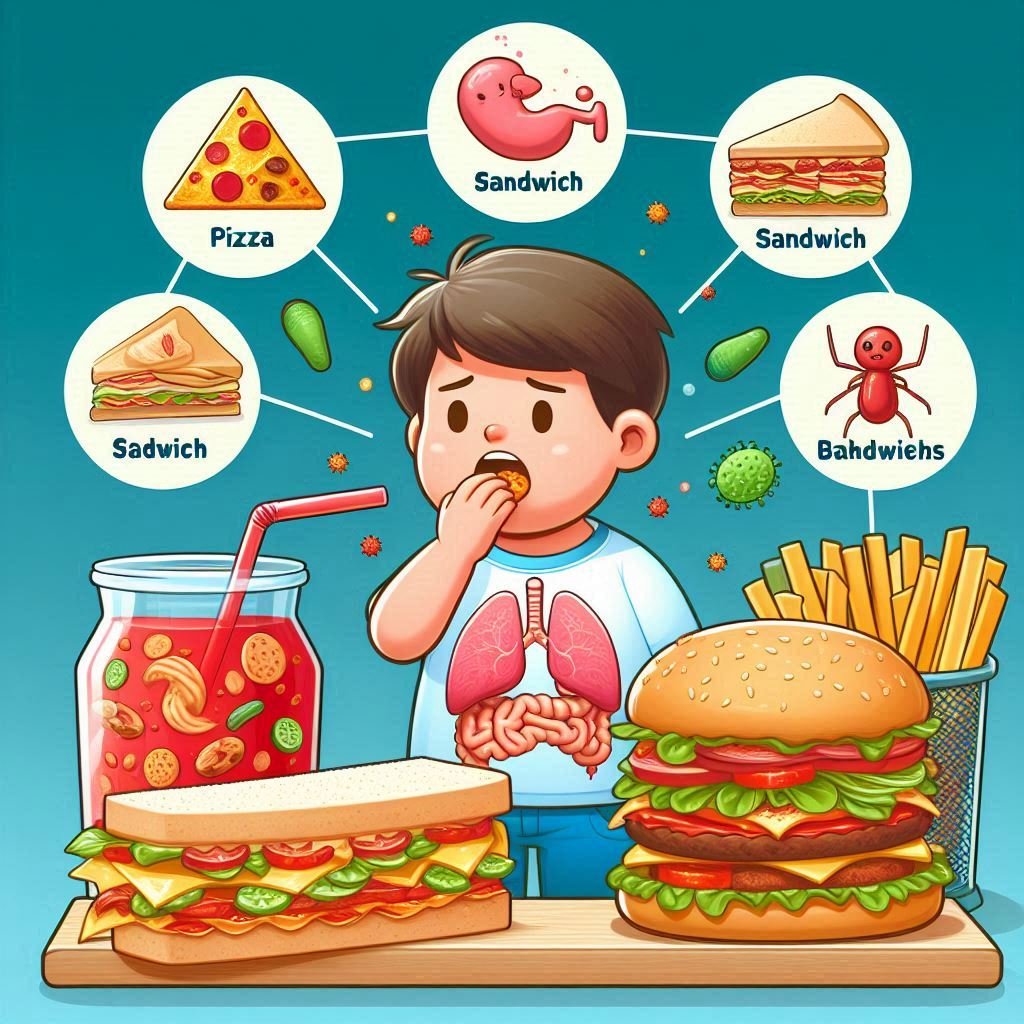The Role of Fast Food in Our Fast-Paced Lives
In today’s fast-paced society, juggling responsibilities from work to family has become the norm. Fast food is essential for our fast paced life, as it offers quick meal options that fit seamlessly into busy schedules. With time often in short supply, many turn to these convenient solutions.
Key Factors Driving Fast Food Reliance
- Affordability: Fast food has become a staple in modern society, attracting millions of consumers globally. Its appeal can be attributed to its affordability. Fast food chains position their offerings at budget-friendly price points, making it easy for families to enjoy meals without breaking the bank. Promotional deals and value menus further enhance their attractiveness, providing economical and satisfying meals, especially during economic uncertainty.
- Convenience: Fast food is essential for our fast paced life, as the demand for quick and accessible meal options has never been greater. Fast food establishments are strategically located in urban areas, catering to those on the go. The speed of service allows busy professionals, students, and families to enjoy a meal without extensive wait times. Drive-thru services add to this convenience, enabling customers to obtain meals without leaving their vehicles.
- Time-Saving: In a world where every minute counts, fast food saves precious time. For many, cooking can feel overwhelming, and the quick nature of fast food becomes a viable alternative. This shift toward convenience often leads to a reliance on fast food as a primary dining option.
- Social Trends: Fast food also reflects societal trends, where speed is prioritized over health. As more people seek quick meals, it’s essential to consider the long-term implications of relying on processed foods.
As we navigate our busy lives, it’s crucial to find a balance between convenience and health. Fast food is essential for our fast-paced life, but exploring healthier alternatives and being mindful of our choices can help us tackle the challenges posed by our modern world.
The Appeal of Fast Food

Fast food has become a staple in modern society, attracting millions of consumers globally. Its appeal can be attributed to several key factors, one of which is affordability. Fast food chains have successfully positioned their offerings at price points that cater to budget-conscious individuals and families. Promotional deals and value menus further enhance their attractiveness, providing meals that are both economical and satisfying. This monetary aspect plays a crucial role in the decision-making process for many consumers, particularly in times of economic uncertainty.
Another significant factor is the convenience that fast food provides. In our fast-paced lives, the demand for quick and accessible meal options has never been greater. Fast food establishments are strategically located in urban areas, making them an ideal choice for those on the go. The speed of service allows individuals to enjoy a meal without extensive wait times, making it an attractive option for busy professionals, students, and families. Additionally, the option of drive-thru services further enhances convenience, enabling customers to obtain meals without leaving their vehicles.
The variety available in fast food menus is also a compelling reason for its popularity. From hamburgers and pizzas to salads and breakfast items, fast food chains offer an extensive range of choices that appeal to diverse tastes and dietary preferences. This wide selection ensures that there is something for everyone, encouraging repeat visits and fostering brand loyalty. Furthermore, innovative menu items and limited-time offers generate excitement and draw in curious consumers keen to try new flavors.
Marketing strategies also play a pivotal role in capturing consumer interest. Fast food companies employ clever advertising that resonates with different demographics, utilizing relatable images and catchy slogans. Their marketing messages often emphasize convenience, affordability, and indulgence, making fast food enticing across various age groups. Coupled with cultural trends that increasingly favor immediate gratification, it’s evident why fast food has secured its place in contemporary dining experiences.
Nutritional Concerns with Fast Food
Fast food has become a ubiquitous element of modern life, offering convenience to those with hectic schedules. However, the nutritional implications of a diet high in fast food are alarming. A significant concern is the excessive caloric content commonly found in these meals. Many fast-food items are calorie-dense, containing more calories than recommended for a single meal. This can lead to increased calorie consumption overall, heightening the risk of weight gain and obesity.
In addition to excessive calories, fast food is often laden with unhealthy fats, particularly trans fats and saturated fats. These fats can negatively impact cholesterol levels, increasing the risk of cardiovascular diseases. Furthermore, many fast-food meals contain high levels of added sugars. Such sugars not only contribute to weight gain but also raise the likelihood of developing insulin resistance, which can lead to type 2 diabetes.
Another critical issue is the elevated sodium content prevalent in fast food. High sodium intake is linked to increased blood pressure, which is a major risk factor for heart disease and stroke. Many individuals do not realize that consuming even a single meal from a fast-food chain can contain a significant portion of the recommended daily sodium intake, which can easily lead to chronic health problems.
Moreover, fast food diets often lack essential nutrients, including vitamins and minerals that are crucial for overall well-being. Regular consumption can result in nutritional deficiencies, affecting bodily functions and contributing to various health issues. It is important for individuals to recognize the long-term consequences of choosing convenience over health, as the implications of a fast-food diet can severely impact physical health over time. By understanding these risks, consumers can make more informed dietary choices that prioritize their long-term well-being.
The Impact of Fast Food on Mental Health
The consumption of fast food has seen a significant rise in modern society, given its undeniable convenience. However, this shift towards processed foods has raised concerns regarding its correlation with mental health issues. Recent studies have linked diets high in fast food to increased levels of anxiety, depression, and stress. Such fast food diets often lack essential nutrients, which play a crucial role in maintaining mental well-being and cognitive function.
Research illustrates that diets rich in refined sugars and unhealthy fats, commonly found in fast food, can lead to detrimental effects on mood. As the body digests these processed foods, it can trigger inflammation and alter the composition of gut microbiota, which is increasingly recognized as pivotal to mental health. The gut-brain axis, a bi-directional communication between the gastrointestinal tract and the brain, suggests that imbalances in gut health can contribute to various psychological disorders. Consequently, individuals who consume fast food regularly may experience a decline in overall emotional stability.
Moreover, studies have demonstrated that a nutrient-poor diet can hinder serotonin production, the neurotransmitter primarily responsible for regulating mood. Individuals consuming a diet high in fast food may find themselves more susceptible to feelings of stress and anxiety than those who incorporate a range of whole foods in their diet. This poses significant implications not only for individual health but also for public health as a whole, as the impact of mental well-being on productivity and societal function cannot be understated.
In light of these findings, it is crucial to recognize the extent to which fast food consumption may affect mental health. As we navigate our fast-paced lives, acknowledging the potential risks associated with heavily processed diets could pave the way for healthier meal choices that support both physical and mental well-being.
Fast Food and Family Dynamics

The pervasive presence of fast food in modern society significantly influences family dynamics and eating behaviors. As families navigate increasingly hectic schedules, the convenience offered by fast food establishments often takes precedence over traditional home-cooked meals. This shift can, in turn, alter the fabric of family interactions and relationships. Meals are frequently consumed on-the-go or in hurried settings, which detracts from the opportunity for families to engage in meaningful conversations during mealtime.
Moreover, the reliance on fast food can unintentionally foster a culture that prioritizes convenience over nutritional quality. For many families, the easy availability and quick preparation associated with fast food lead to a decrease in culinary skills, particularly among the younger generation. Children and adolescents who frequently eat fast food may miss out on critical lessons about nutrition, cooking techniques, and the importance of balanced diets. As a result, the dietary habits formed early in life can set the stage for future health implications, contributing to the prevalence of obesity and related health issues.
Additionally, the reduction of shared meal times often results in diminished family bonding. Frequent fast food consumption encourages fragmented family experiences, whereby members consume different meals at varying times due to conflicting schedules. This lack of shared dining experiences can diminish family cohesion and reduce opportunities for parents to model healthy eating behaviors for their children. It becomes crucial to address how these eating patterns disrupt traditional family structures and the potential long-term impact on the family’s collective health values.
In conclusion, the integration of fast food into family life presents a duality of convenience and health risks. While it caters to the demands of modern living, the implications for family dynamics and nutrition are worth careful consideration. Families must strive to find a balance that incorporates the benefits of convenience without sacrificing the essential elements of nutrition and family connections.
Alternatives to Fast Food: Quick and Healthy Options
In today’s fast-paced world, many individuals find themselves reaching for fast food due to its convenience. However, a variety of healthier alternatives can easily fit into busy lifestyles without sacrificing nutrition or flavor. By implementing practical strategies, you can enjoy quick and nutritious meals that support your well-being.
Meal Prepping: One of the most effective methods for ensuring healthy options are readily available is meal prepping. Setting aside a few hours each week to prepare meals can drastically reduce the time spent cooking during hectic weekdays. Dishes such as quinoa salads, vegetable stir-fries, and whole grain wraps can be made in advance and stored in the refrigerator. By incorporating a mix of proteins like grilled chicken, beans, or tofu, you can create satisfying meals that provide energy and nutrition.
Easy Recipes: Embracing simple recipes that require minimal ingredients is another way to enjoy quick, healthy meals. Smoothies are an excellent option for incorporating fruits and vegetables into your diet. A quick blend of spinach, bananas, and almond milk can create a nutrient-dense meal in minutes. Similarly, omelets made with eggs and your choice of vegetables make for a protein-rich breakfast or dinner that can be prepared quickly. These options ensure that you can enjoy nutritious meals without spending too much time in the kitchen.
Smart Grocery Choices: When time is tight, making informed choices at the grocery store can also contribute to healthier eating. Opt for pre-cut vegetables, canned beans, or microwaveable brown rice, which can save considerable time while still providing nutritious options. Keeping your pantry stocked with healthy snacks—such as nuts, yogurt, or hummus—can offer quick, satisfying refueling options that are more wholesome than grabbing fast food on the go.
Mindful Eating Habits: It’s also beneficial to develop mindful eating habits. This means being conscious of what you’re eating, understanding portion sizes, and listening to your body’s hunger cues. Preparing meals at home allows you to control ingredients and portions, fostering a healthier relationship with food.
By adopting these alternatives, you can cultivate healthier eating habits while maintaining the convenience that modern life demands. This balanced approach encourages individuals to prioritize their nutritional well-being, making it easier to avoid fast food, even during the busiest times. Making small changes can lead to significant improvements in your overall health and lifestyle, empowering you to thrive in a fast-paced world.
The Role of Fast Food Industry in Public Health
The fast food industry has become a significant player in the contemporary public health landscape, particularly as rates of obesity, diabetes, and other diet-related diseases continue to rise. The products offered by these chains are often high in calories, fats, sugars, and sodium, which contribute to various health issues when consumed frequently. As a result, this industry carries a responsibility to its consumers, necessitating transparency in food sourcing and nutritional content. Many fast food chains are now implementing clearer nutritional labeling on their menus, which is a step towards providing consumers with the information needed to make healthier choices.
The effect of fast food in our life read in Hindi, Click Here
Despite the pressures of competition and cost-efficiency, there is an emerging call for fast food restaurants to reevaluate their menus to accommodate health-conscious customers. This includes the introduction of healthier menu options such as salads, whole grain items, and lower-calorie dishes that provide nutritional value without compromising the convenience that fast food is known for. Some establishments are also exploring plant-based alternatives, responding to the increasing demand for vegetarian and vegan meals among consumers.
Moreover, the potential for positive change exists through initiatives in corporate social responsibility. Many fast food companies are beginning to engage in community health programs, such as sponsoring fitness events or educational campaigns focused on nutrition. These efforts not only enhance their public image but also contribute to healthier communities. The industry’s involvement in local health initiatives may prove to be a crucial factor in mitigating the crisis associated with unhealthy eating habits. As the fast food sector adapts to contemporary health concerns, it holds the power to foster beneficial changes, ultimately promoting better health outcomes for the public.
Legislation and Regulation: A Path Towards Healthier Fast Food
The interplay between legislation, regulation, and public health is crucial in addressing the health risks associated with fast food consumption. Governments worldwide are increasingly recognizing the need for policies that promote healthier eating habits and mitigate the adverse effects of fast food on public health. Existing regulations focus on various aspects, including caloric labeling, nutritional information, and advertising restrictions targeting children.
Caloric labeling laws, for example, require fast food chains to display calorie counts clearly on their menus. This initiative aims to empower consumers with the information necessary to make informed food choices. Several studies have shown that when consumers have access to nutritional information, they tend to select lower-calorie options, thus potentially reducing their overall calorie intake. Such legislative measures can play a significant role in curbing obesity rates and associated health issues.
In addition to caloric labeling, zoning laws can help regulate the proliferation of fast food outlets in particular neighborhoods. These laws can encourage the establishment of healthier food alternatives, promoting a more balanced food environment. By limiting the density of fast food establishments, especially in areas with high rates of obesity and poverty, communities can foster healthier eating habits among residents.
International approaches to regulating fast food have also shown effectiveness. Countries like Denmark and Japan have implemented strict regulations on portion sizes and advertising, particularly focused on vulnerable populations such as children. These strategies not only enhance public health but also create a framework for a cultural shift towards healthier dietary practices.
In conclusion, effective legislation and regulation represent critical components in the quest for healthier fast food options. By implementing comprehensive policies that target various aspects of the fast-food industry, governments can facilitate a healthier environment and combat the negative health trends associated with fast food consumption.
Conclusion: Striking a Balance
As we navigate through our fast-paced lives, the dilemma of fast food consumption continues to present unique challenges. The allure of convenience provided by fast food often clashes with the necessity for healthier dietary choices. Throughout this discussion, we have highlighted the significant implications of fast food on health and well-being. The convenience that fast food caters to can pose risks, such as increasing the likelihood of obesity, heart disease, and other chronic health issues.
It is crucial for individuals to recognize that while fast food offers quick and readily available options, such choices need to be made with deliberation. The convenience factor should not overshadow the importance of nutritional value in our diets. One effective strategy is to integrate a variety of food options that prioritize health while still accommodating a busy lifestyle. This may involve planning meals in advance, exploring healthier alternatives at fast-food establishments, or even preparing quick, nutritious meals at home.
Moreover, making informed decisions about food choices can help mitigate the negative health impacts associated with fast food. Understanding the nutritional content and potential long-term effects can empower individuals to strike a balance between satisfying their craving for convenience and prioritizing their health. It is essential to consider one’s dietary habits holistically, ensuring that the choices made today do not compromise future health.
In conclusion, finding balance in fast food consumption is not merely about choosing between convenience and health; it is about harmonizing both aspects to foster a sustainable and healthy lifestyle. By being mindful of our eating patterns and making conscious decisions, we can navigate our fast-paced world while promoting our overall well-being. Encouraging this balance can lead to healthier outcomes, ultimately enhancing both our quality of life and longevity.



